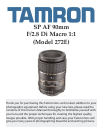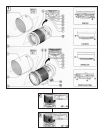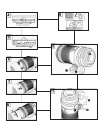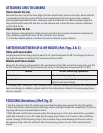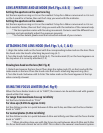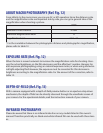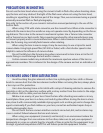
PRECAUTIONS IN SHOOTING
Do not use the lens hood when using the camera's built-in flash. Also, when shooting close-
ups, the lens unit may obstruct the light of the flash even when not using the lens hood,
resulting in vignetting at the bottom part of the image. Thus, we recommend using a special
externally mounted flash or flash photography.
Also refer to the section of your camera's instruction manual pertaining to the use of the
built-in flash.
When using 272E with a tele-converter, use the manual focus.When a tele-converter is
used with the macro lens, the autofocus may not operate correctly, depending on the focus-
ing distance.This is due to the camera's mechanical system. Use a Tamron tele-converter
with a Tamron lens or best results. Tele-converters produced by other manufacturers may
not mount properly and/or cause malfunctions. When a tele-converter is mounted onto a
lens, the focusing ring normally feels heavier when rotating.
When using the lens in macro range, it may be necessary to use a tripod to avoid
camera shake. Using high-speed film (ISO 400 or faster) with a fast shutter speed is also
helpful to reduce the influence of camera shake.
Do not forcibly turn the focusing ring when camera and/or lens is/are set in the AF
mode. Doing so could damage the lens and/or camera.
Certain camera models may indicate the maximum aperture values of the lens as
approximate numbers.This is inherent to the design of the camera and not an indication of
error.
TO ENSURE LONG-TERM SATISFACTION
Avoid touching the glass element surface. Use a photographic lens cloth or blower
brush to remove dust from the lens element surface. When not using the lens, always place
a lens cap on it for protection.
Use a lens cleaning tissue or lint cloth with a drop of cleaning solution to remove fin-
gerprints or dirt on the glass lens surface with a rotary motion from the center to the edge.
Use a silicon cloth to clean your lens barrel only.
Mildew is an enemy of your lens. Clean the lens after shooting near water or in any
humid place. Store your lens in a clean, cool and dry place. When storing the lens in a lens
case, store it with commercially available drying agent such as silica gel, and in change the
agent occasionally. If you find mildew on your lens, consult an authorized repair shop or
nearby photographic store.
Do not touch the lens-camera interface contacts since dust, dirt, and/or stains may
cause a contact failure between the lens and camera.
When using your equipment [camera(s) and lens(es)] in an environment where the
temperature changes from one extreme to the other, make sure to put your equipment
temporarily in a case or a plastic bag for a length of time in order for the equipment to go
through a gradual temperature shift. This will reduce potential equipment trouble.



